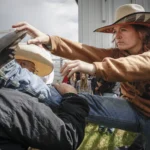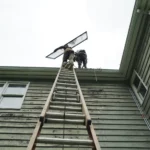FRIDAY FOCUS: WDOC Director Shares Challenges, Future Goals for State Correctional System (Part 2)
Top corrections official seeks more staff, new penitentiary
- Published In: Other News & Features
- Last Updated: May 05, 2023

By Shen Wu Tan
Special to the Wyoming Truth
Overseeing five state prisons and a biennial budget of $262 million is no easy task. But it’s a rewarding one for Dan Shannon.

Shannon, director of the Wyoming Department of Corrections (WDOC) since 2020, has worked in the criminal justice system for nearly four decades.
In part one of the Wyoming Truth’s Friday Focus series on the state’s corrections system, Shannon spoke about current initiatives and staff shortages at the state agency. In part two, he discussed legislation that impacts the corrections system and facility updates, among other topics. What follows are excerpts from the interview.
Did you support Senate Enrolled Act 67, which bans drones over penal institutions?
Shannon: I was a driver of that legislation in the sense that I asked for it to be considered [by the Wyoming Legislature]. Unfortunately, it’s the sign of the times. With technology, we get a lot of positive things, and we also get negative. And the purpose is to protect our staff and our inmates, as well as our society. Now, that was really a balancing act…. Many states have bans. We don’t have much problem with drones, but that doesn’t mean we won’t in the future because most states do now. Drones are dropping contraband, dropping weapons inside facility grounds.
I felt I had to support [the bill] in any way I could to make sure we had some form of protection with the [increase] of people trying to get fentanyl inside institutions and weapons.
Are there any misconceptions about Wyoming corrections you would like to address?
Shannon: It takes an entire workforce to ensure the safety of our communities and to work with individuals. We have electricians. We have maintenance staff, food service workers, educators…. We need assessments. We need mental health workers. We need substance use treatment providers. I don’t know if we realize, as a whole, the amount of diversity of workers it takes to ensure that we can have a productive system.
I also don’t believe [the public] really understand how these folks risk their lives each day to ensure our state is safer and our confined individuals who are returned back to them are safer…. Our parole agents risk their lives every day, supervising over 6,500 felons, to do the best possible job they can to ensure our state is safe. And I’m really privileged and proud to work with folks like that.
What do you want the public to know about how the corrections system operates?
Shannon: Really, what our responsibility is—not only to keep the community safe and protect the victims, [but] 95% of those individuals within the next five years are going to be returned to our communities. And when you say it in that aspect, it’s a huge undertaking, the responsibility we have to ensure that a better individual returns to their communities than what we received them as.
We are actually a community within a community. And everything that takes place in the community almost takes place inside of our prisons. We have education. We have work programs. We have individuals who are very sickly. We have individuals [who] are going to pass. Bad things happen sometimes in prison regardless of how hard you try to prevent it. As I said, it’s our responsibility that all convicted felons in Wyoming are being supervised, and we’re trying to return [them] as better persons.
Tell me about your current goals.
Shannon: Staff retention is our number one priority, to be able to hire more staff so we don’t have to ship people out. . . . We’re covering all of our shifts, but I don’t want to see that worsen.
In the future, it would be my intent that we obtain the ground and start phase one for a new penitentiary. We’re presently setting money aside every year to build a new penitentiary that’s more modern, that has [fewer] mechanical problems and is more fitting for our mission.
As I mentioned earlier…to have our staff and inmates work electronically throughout the day…. I’m trying to get WiFi at our facilities…. Through a grant through Wyoming Department of Workforce Services, we’ve purchased tablets for our inmates. And through our budget, we’ll be purchasing tablets for our staff.
There would be designated programming and set times [for the inmates]…The inmates who are required to work on their education, that’s when the tablets are utilized. Tablets could be utilized for possible visitations, job interviews, things of that nature. Regarding staff usage of it, it would be for our maintenance staff to log maintenance procedures. It would be for our correctional officers to do daily counts.
Are any facility renovations in the works?
Shannon: At WHCC, which is our Wyoming Honor and Conservation Camp, we did some revamping, and we’re continuing to do some small modifications. We have our female ITU, it’s our intensive treatment unit, there now. We have our veterans’ program down there and…it’s more dormitory style. We have two shell units at WMCI (Wyoming Medium Correctional Institution). We were going to build out those units, but because our population has not been growing, we’re not going to build that at this time.
What’s the latest with the dog training programs at WDOC prisons?
Shannon: With the dog training program at WMCI, we recently started a hearing-impaired service dog training component. That’s new. At our Wyoming State Penitentiary, we never had a dog program. It was the last facility that didn’t have a dog program. We’re going to have one this year. To me, it’s an incredible program. We’re assisting the local shelters. We’re helping the animals.
The dogs that are being adopted back have the benefit of being well-trained…. I believe interactions with the canines also provides a calming effect inside the institutions, and it provides those who have mainly only focused on themselves to learn a skill set that they can also provide love and care for another.
It teaches people to respect. It teaches individuals to care for others, maybe sometimes for the first time in their lives. To me, these individuals [in the community who adopt the dogs] are receiving a great benefit. Our program is certified…so they’re assured that as best as possible that they are getting a good quality, healthy animal that has received extensive training around multiple different personalities, environments, noises. So, I think it would make a much more suitable and desirable pet to have in their home as their family member.













